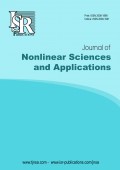Lie group classification of the nonlinear transmission line model and exact traveling wave solutions
-
1307
Downloads
-
3418
Views
Authors
T. Amtout
- Department of Mathematics, Laboratory of Mathematics and Applications (LMA), Faculty of Sciences and Techniques, University Abdel Malek Essaadi, UAE, BP 416, Km 10, Ziaten, 90000, Tangier, Morocco.
M. Er-Riani
- Department of Mathematics, Laboratory of Mathematics and Applications (LMA), Faculty of Sciences and Techniques, University Abdel Malek Essaadi, UAE, BP 416, Km 10, Ziaten, 90000, Tangier, Morocco.
M. El Jarroudi
- Department of Mathematics, Laboratory of Mathematics and Applications (LMA), Faculty of Sciences and Techniques, University Abdel Malek Essaadi, UAE, BP 416, Km 10, Ziaten, 90000, Tangier, Morocco.
Abstract
A nonlinear transmission line (NLTL) model is very essential tools in understanding of propagation of electrical solitons which can propagate in the form of voltage waves in nonlinear dispersive media. These models are often formulated using nonlinear partial differential equations. One of the basic tools available to study these equations are numerical methods such as finite difference method, finite element method, etc, have been developed for nonlinear partial differential equations. These methods require a great amount of time and memory due to the discretization and usually the effect of round-off error causes loss of accuracy in the results. So in this paper, we use one of the most famous analytical methods the Lie group analysis due to Sophus Lie. One of the advantages of this approach is that requires only algebraic calculations. The main aim of this study is to explore the nonlinear transmission line model with arbitrary capacitor's voltage dependence, through the use of Lie group classification, we show that the specifying form of arbitrary capacitor's voltage are power law nonlinearity, exponential law nonlinearity and constant capacitance. The exact solutions and similarity reductions generated from the symmetries are also provided. Furthermore, translational symmetries were utilized to find a family of traveling wave solutions via the \(\tanh\)-method of the governing nonlinear problem.
Share and Cite
ISRP Style
T. Amtout, M. Er-Riani, M. El Jarroudi, Lie group classification of the nonlinear transmission line model and exact traveling wave solutions, Journal of Nonlinear Sciences and Applications, 15 (2022), no. 4, 267--275
AMA Style
Amtout T., Er-Riani M., El Jarroudi M., Lie group classification of the nonlinear transmission line model and exact traveling wave solutions. J. Nonlinear Sci. Appl. (2022); 15(4):267--275
Chicago/Turabian Style
Amtout, T., Er-Riani, M., El Jarroudi, M.. "Lie group classification of the nonlinear transmission line model and exact traveling wave solutions." Journal of Nonlinear Sciences and Applications, 15, no. 4 (2022): 267--275
Keywords
- Lie group classification
- non-linear line transmission
- traveling wave solutions
MSC
References
-
[1]
E. Afshari, A. Hajimiri, Nonlinear Transmission Lines for Pulse Shaping in Silicon, IEEE J. Solid-State Circuits, 40 (2005), 744--752
-
[2]
T. Amtout, M. Er-Riani, M. El Jarroudi, Applications of Lie Symmetry Analysis to the Natural Convection Flow of Boundary Layer Past an Inclined Surface, Adv. Intell. Syst. Comput., 1418 (2022), 1053--1066
-
[3]
H. Biyadi, T. Amtout, M. Er-Riani, M. El Jarroudi, Lie Symmetry Analysis of a Class of Thermal Conduction Models, Appl. Math. Sci., 13 (2019), 1061--1067
-
[4]
G. W. Bluman, S. Kumei, Symmetries and differential equations, Springer-Verlag, New York (1989)
-
[5]
A. Chauhan, R. Arora, A. Tomar, Lie Symmetry Analysis and traveling wave solutions of equal width wave equation, Proyecciones, 39 (2020), 179--198
-
[6]
M. M. El-Borai, H. M. El-Owaidy, H. M. Ahmed, A. H. Arnous, Exact and soliton solutions to nonlinear transmission line model, Nonlinear Dyn., 87 (2017), 767--773
-
[7]
H. Gandhi, D. Singh, A. Tomar, Explicit Solution of General Fourth Order Time Fractional KdV Equation by Lie Symmetry Analysis, AIP Conference Proceedings, 2253 (2020), 14 pages
-
[8]
H. Gandhi, A. Tomar, D. Singh, Conservation laws and exact series solution of fractional-order Hirota-Satsuma-coupled Korteveg-de Vries system by symmetry analysis, Math. Methods Appl. Sci., 44 (2021), 14356--14370
-
[9]
N. Ibragimov, CRC Handbook of Lie Group Analysis of Differential Equations, CRC Press, Boca Raton (1995)
-
[10]
M. A. Kayum, M. Ali Akbar, M. S. Osman, Competent closed form soliton solutions to the nonlinear transmission and the low-pass electrical transmission lines, Eur. Phys. J. Plus, 135 (2020), 20 pages
-
[11]
D. Kumar, A. R. Seadawy, M. R. Haque, Multiple soliton solutions of the nonlinear partial differential equations describing the wave propagation in nonlinear low-pass electrical transmission lines, Chaos Solitons Fractals, 115 (2018), 62--76
-
[12]
W. Malfliet, Solitary wave solutions of nonlinear wave equation, Amer. J. Phys., 60 (1992), 650--654
-
[13]
S. I. Mostafa, Analytical study for the ability of nonlinear transmission lines to generate solitons, Chaos Solitons Fractals, 39 (2009), 2125--2132
-
[14]
P. J. Olver, Application of Lie Group to Differential Equation, Springer-Verlag, New York (1986)
-
[15]
L. V. Ovsiannikov, Group Analysis of Differential Equations, Academic Press, New York (1982)
-
[16]
M. N. O. Sadiku, L. C. Agba, A Simple Introduction to the Transmission-Line Modeling, IEEE Trans. Circuits and Systems, 37 (1990), 991--999
-
[17]
A.-M. Wazwaz, The tanh-method for traveling wave solutions of nonlinear equations, Appl. Math. Comput., 154 (2004), 713--723
-
[18]
A.-M. Wazwaz, Analytic study of the fifth order integrable nonlinear evolution equations by using the tanh method, Appl. Math. Comput., 174 (2006), 289--299
-
[19]
A.-M. Wazwaz, The tanh method for travelling wave solutions to the Zhiber-Shabat equation and other related equations, Commun. Nonlinear Sci. Numer. Simul., 13 (2008), 584--592

